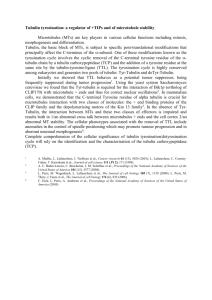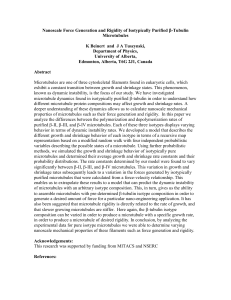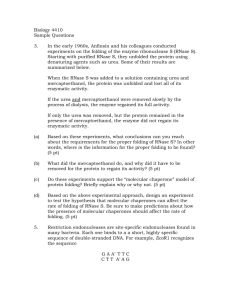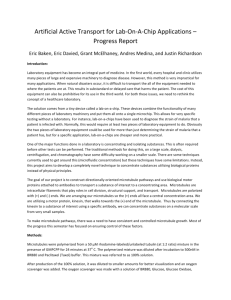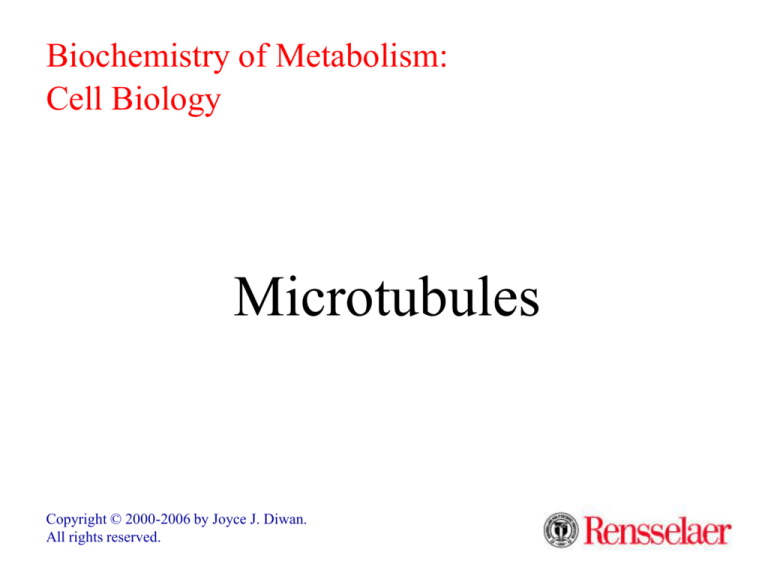
Biochemistry of Metabolism:
Cell Biology
Microtubules
Copyright © 2000-2006 by Joyce J. Diwan.
All rights reserved.
An a,b-tubulin heterodimer
is the basic structural unit of
microtubules.
ab
GTP
GTP
The heterodimer does not come
apart, once formed.
tubulin
heterodimer
The a & b tubulins, each about 55 kDa, are homologous
but not identical. Each has a nucleotide binding site.
a-Tubulin has a bound GTP, that does not hydrolyze.
b-Tubulin may have bound GTP or GDP.
Under certain conditions, b-tubulin can hydrolyze its
bound GTP to GDP plus Pi, release Pi, and exchange
the GDP for GTP.
A microtubule is a hollow
cylinder, about 24 nm in diameter.
b-GTP
a-GTP
+
Along the microtubule axis, tubulin
heterodimers join end-to-end to
form protofilaments, with
alternating a & b subunits.
b-GDP
a-GTP
Staggered assembly of 13
seam
protofilaments yields a helical
arrangement of tubulin
microtubule 3-start helix
heterodimers in the cylinder wall.
Website with an image of a 3-D reconstruction of the
structure of an intact microtubule, based on cryo-EM and
image processing (by the Visualization Group at Lawrence
Berkeley National Laboratory, K. Downing's research group).
b-GTP
a-GTP
Electron microscopy of
microtubules decorated with
motor protein heads indicate a
"3-start helix.“
Each turn of the helix spans 3
tubulin monomers (e.g., a, b, a).
b-GDP
a-GTP
+
seam
microtubule 3-start helix
This results in the wall having a "seam" where, instead
of the predominant aa & bb lateral contacts, a subunits
are laterally adjacent to b.
During in vitro microtubule
assembly, heterodimers join endto-end to form protofilaments.
b-GTP
a-GTP
+
These associate laterally to form
sheets, & eventually microtubules.
Heterodimers can add or dissociate
at either end of a microtubule in
vitro, but there is greater tendency
for subunits to add at the plus end,
where b-tubulin is exposed.
b-GDP
a-GTP
seam
microtubule 3-start helix
As with actin filaments, microtubules can undergo
treadmilling, with:
• addition of tubulin heterodimers at the plus end
• dissociation of tubulin heterodimers at the minus end.
abab
GTP
GDP
GTP
GTP
()
protofilament
(+)
GTP must be bound to both a & b subunits for a tubulin
heterodimer to associate with other heterodimers to form
a protofilament or microtubule.
Subunit addition brings b-tubulin that was exposed at the
plus end into contact with a-tubulin.
This promotes hydrolysis of GTP bound to the now
interior b-tubulin. Pi dissociates, but b-tubulin within a
microtubule cannot exchange its bound GDP for GTP.
The GTP on a-tubulin does not hydrolyze.
abab
GTP
GDP
GTP
GTP
()
protofilament
(+)
The minus end of a-tubulin may contribute an essential
residue to the catalytic site of b-tubulin.
Thus the minus end of an a subunit may serve as GAP
(GTPase activating protein) for b-tubulin of the adjacent
dimer in a protofilament.
A homologous bacterial protein FtsZ is considered the
ancestor of tubulin.
FtsZ, which has a role in bacterial cytokinesis, also
assembles into protofilaments, and the FtsZ
protofilaments can associate to form sheets or tubules.
abab
GTP
GDP
GTP
GTP
()
protofilament
(+)
Protofilament structure has been determined at atomic
resolution using cryo-EM (electron diffraction) analysis
of 2-D crystals induced by treating tubulin with zinc ions
in the presence of a derivative of the drug taxol.
These “zinc sheets” consist of parallel arrays of
protofilaments.
tubulin a,b dimer
taxol
GTP
minus
end
GDP
plus
end
a
b
PDB 1JFF
Each nucleotide in the protofilament is at an a-b interface.
The inability of GTP to dissociate from the a-subunit is
consistent with occlusion by a loop from the b-subunit.
A similar occlusion would account for the inability of
b-tubulin within a protofilament to exchange GDP/GTP.
GDP
The nucleotide binds
adjacent to a b-sheet
(in magenta).
The nucleotide binding
site of tubulins is
structurally similar to
the nucleotide binding site
of GTP-binding proteins
b-tubulin
of the Ras superfamily.
PDB 1JFF
Nucleotide binding sites of the motor proteins myosin
and kinesin (to be discussed later) are also structurally
similar to that of Ras.
GDP
b-tubulin
PDB 1JFF
The nucleotide-binding domain of tubulins includes a
highly conserved sequence GGGTG(T/S)G, shown in
black, that is part of a loop & helix that extends from one
of the b-strands & passes near the nucleotide phosphates.
View an animation depicting assembly of
microtubules.
Then explore the structure of the a,b-tubulin
heterodimer, using Chime.
A
B
A
B
C
Doublet & triplet microtubules: The wall of one
microtubule partly consists of the wall of an attached
microtubule.
The A tubule is a complete microtubule cylinder, made
of 13 protofilaments. “Piggyback” B or C tubules are
made of less than 13 protofilaments, usually 10.
Centrioles are cylindrical
structures, usually found in
pairs orientated at right angles
to one another.
The wall of each centriole
cylinder is made of nine
interconnected triplet
microtubules, arranged as
a pinwheel.
Centrioles at right angles,
as in the centrosome.
cartwheel structure
at one end
The interior of each centriole appears empty, except for a
"cartwheel" structure at one end.
Electron micrographs show appendages that protrude
from the outer surface at one end of a mature centriole, &
fibrous structures connecting the two centriole cylinders.
Centriolar microtubules are
relatively stable.
The a,b tubulin heterodimers
present in centriolar triplet
microtubules are modified by
polyglutamylation.
Additional tubulins d,e,z,&h,
as well as other proteins, are
either present in centrioles or
required for their formation.
Centrioles at right angles,
as in the centrosome.
cartwheel structure
at one end
There is some variability in composition among different
organisms.
Basal bodies of cilia & flagella are also centrioles.
Electron micrograph in article by J. Beisson & M. Wright.
Centriole
cylinders
separate.
(Biogenesis of
ciliary basal
bodies, which is
somewhat different,
will not be
discussed here.)
Shorter cylinders
of same diameter
appear at right
angles & lengthen.
During centriole duplication prior to mitosis (G1-S phase):
The 2 centriole cylinders separate.
A daughter centriole grows from a short disk-like
structure at right angles to each parent centriole.
A line through each daughter centriole bisects the parent.
Centrioles at right angles,
as in the centrosome.
cartwheel structure
at one end
The centrosome, a mass of protein also called the
microtubule organizing center (MTOC) or pericentriolar
material, surrounds centrioles in animal cells.
Following duplication, the pericentriolar material initially
is associated only with each parent centriole cylinder.
Centrioles at right angles,
as in the centrosome.
Proteins present in the
pericentriolar material or on
the surface of centrioles
include centrin, pericentrin,
ninein, cenexin, CEP110,
CEP250 (C-Nap1), g-tubulin,
and others.
cartwheel structure
at one end
Labeling studies have shown such proteins to be located
at one end and along lateral margins of the centriolar
cylinder, forming a mass the shape of a tube.
See Fig. 2 in article by Ou et al.
lockwasher
shape
cap
g-tubulin ring complex
g-Tubulin, which is homologous to a & b tubulins,
nucleates microtubule assembly within the centrosome.
Several (12-14) copies of g-tubulin associate in a complex
with other proteins called “grips” (gamma ring proteins).
This g-tubulin ring complex is seen by EM to have an
open ring-like structure resembling a lock washer,
capped on one side.
Microtubules nucleated by the
g-tubulin ring complex appear
capped at one end, assumed from
other data to be the minus end.
lockwasher
shape
cap
g-tubulin ring complex
Polymerization at the minus end of these microtubules
is inhibited.
Grip proteins of the cap may be involved in mediating
binding to the centrosome.
Phosphorylation of a conserved tyrosine residue of
g-tubulin has been shown to regulate microtubule
nucleation in yeast cells.
Website with micrographs & diagrams.
centrosome
astral
microtubule
polar
microtubule
chromosomal
microtubule
During cell division, the duplicated centrosome helps to
organize the mitotic spindle.
MTOC
nucleus
microtubules
During interphase, the centrosome (MTOC) is usually
located near the nucleus.
Microtubules grow out from the MTOC, forming a hub
& spoke array, even during interphase.
MTOC
With minus ends of most
microtubules anchored in the
centrosome, microtubules
grow & shrink mainly
through addition & loss of
tubulin heterodimers at their
plus ends.
nucleus
microtubules
A sub-population of microtubules with free minus ends
exists in some cells.
These may arise by breakage or cleavage of microtubules.
Dynamic
instability:
slower
Microtubules
growth
microtubule
may grow
length
steadily & then
shrink rapidly by
rapid
loss of tubulin
disassembly
dimers at the
time
plus end.
The rapid disassembly is called catastrophe.
In vitro, a tendency to grow or shrink depends on [tubulin].
As microtubules grow, tubulin dimers are depleted.
Below a critical tubulin concentration, rapid shrinkage at the
plus end has been attributed to loss of a GTP cap.
Hydrolysis of GTP by
b-tubulin, as polymerization
brings it into contact with
a-tubulin, takes time.
b-GTP
a-GTP
A rapidly growing microtubule
may accumulate a few layers of
tubulin-GTP at the (+) end.
b-GDP
a-GTP
A GTP cap stabilizes the
plus end of a microtubule.
+
seam
microtubule 3-start helix
If the concentration of tubulin heterodimers is low,
dissociation of tubulin-GTP may expose tubulin-GDP at
the plus end, causing that end to be unstable.
Rapid shrinkage ensues.
Fraying or curving of
protofilaments is
observed at the ends of
rapidly disassembling
microtubules.
This may be due to a
change in conformation
when b-subunits at the
plus end have bound
GDP instead of GTP.
protofilament
microtubule
during rapid
shortening at
the plus end
Tubulin heterodimers with GDP on the b subunit form
ring shaped assemblies in vitro.
Straight protofilaments form only when both tubulins
have bound GTP.
Dynamic instability of microtubules in vivo is regulated
by interaction with other proteins.
E.g., during prophase of mitosis, microtubules grow out
from the centrosome.
If the plus end of a microtubule makes contact with a
chromosome, the end becomes stabilized.
Otherwise rapid disassembly at the plus end ensues, and
the tubulin dimers are available for growth of another
microtubule.
A website of the Borisy lab has movies depicting
microtubule instability. See, e.g., movie #1 on
centrosomal control of microtubule dynamics.
MAPs (microtubule-associated proteins) are a diverse
class of proteins that bind to microtubules.
Binding of MAPs may be regulated by phosphorylation,
which causes some MAPs to detach from microtubules.
+TIPS, or plus-end tracking proteins, associate with
the plus ends of microtubules.
Many +TIPs are motor proteins.
Some mediate interaction with the actin cytoskeleton
in the cell cortex, adjacent to the plasma membrane.
Some +TIPS regulate microtubule dynamics and
stability at the plus end.
+TIPS (plus-end binding proteins) that stabilize or
promote growth of microtubules include, e.g.:
Members of the XMAP215 family of proteins stabilize
plus ends of microtubules, preventing catastrophic
shrinkage and promoting microtubule growth.
CLASPs are proteins that promote addition of tubulin
dimers at the plus end and inhibit catastrophe.
They are associated with kinetochores, the complexes
that link plus ends of mitotic spindle microtubules to
chromosomes.
Catastrophe-promoting proteins (catastrophins) bind to
plus ends of microtubules & promote dissociation of
tubulin dimers.
They may activate GTP hydrolysis or induce a curved
protofilament conformation.
E.g., MCAK, a member
of the kinesin family of
proteins, promotes
dissociation of tubulin
dimers at the
kinetochore, as
kinetochore-linked
microtubules shorten in
anaphase of mitosis.
Shortening of chromosomal
spindle microtubules in anaphase A
()()
kinetochore
free tubulin
In vitro, MCAK can cause microtubules to shrink at
both ends.
Movie of microtubule shortening after MCAK addition
(video supplement #1, article of Helenius et al).
Other proteins that promote microtubule disassembly:
Stathmin is a microtubule destabilizing protein that
increases in abundance in some cancer cells.
It binds to tubulin heterodimers, decreasing their
availability for polymerization.
Stathmin is inhibited by phosphorylation.
Katanin severs microtubules, generating:
• new plus ends that lack a stabilizing GTP cap
• minus ends that are not stabilized by being capped
by g-ring complexes of the centrosome.
KLP10A & related members of the Kin I subfamily of
kinesins associate with uncapped minus ends of
microtubules at the spindle poles during mitosis.
They promotes dissociation of tubulin dimers at the
poles of the cell, contributing to:
• treadmilling (flow of subunits toward the poles)
• shortening of kinetochore-linked microtubules during
anaphase of mitosis.
Some MAPs cross-link adjacent microtubules or link
microtubules to membranes or to intermediate filaments.
The length of intervening segments between binding
domains in particular MAPs may determine the spacing
of microtubules in parallel arrays.
Some examples:
Type I MAPs, in axons & dendrites of nerve cells &
in some non-neural cells, have several repeats of the
sequence KKEX (Lys-Lys-Glu-X) that binds to
negatively charged tubulin domains.
Type II MAPs (e.g., MAP4 & Tau), in axons,
dendrites & non-neural cells, have 3-4 repeats of an
18-residue sequence that binds tubulin.
Toxins & Drugs
Some toxins and drugs (all of which inhibit mitosis)
affect polymerization or depolymerization of tubulin:
Taxol, an anti-cancer drug, stabilizes microtubules.
Colchicine binds tubulin & blocks polymerization.
Microtubules depolymerize at high [colchicine].
Vinblastine causes depolymerization and
formation of vinblastine-tubulin paracrystals.
Nocodazole causes depolymerization of
microtubules.


